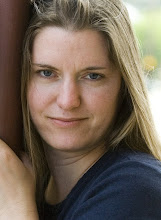Photo - Paul Devereaux from the Fortean Times
Related to my previous post about The Graveyard Road in my hometown, I've been doing some research lately on the lore of the Coffin Road, sometimes referred to as a Corpse Road or Lych Way. They were medieval creations in Europe, primarily the UK from what I can gather, and although they started out as political tools, have all sorts of interesting myths surrounding their creation and use.
In the Middle Ages, the Roman Catholic church reigned supreme in Europe. Individual parish churches were numerous - sometimes too numerous for the populations in their immediate vicinity. In order to guarantee a bit of revenue from funeral and burial fees, they asked for and received permission to require residents of certain areas to use a specific church for the burial of their dead. Sometimes families had to transport their loved ones several miles in order to reach the cemetery where they had to be buried. In order to facilitate this transport, paths and small lanes were constructed, leading from various villages and settlements to the graveyards they had been assigned. Some even had large "coffin stones" carved on which to occasionally rest Grampa or Uncle Joe, as carrying a full coffin for several miles over sometimes rough terrain could be pretty tiring.
As you can imagine, lots of stories, traditions and folklore sprang up around these highways of the dead. People in those times had no scientific explanations for the odd lights that showed up occasionally in fields at night, or why little Susie came down with a mysterious illness no one could explain or cure. People really, really believed in curses and ghosts, and took them very seriously. Care was taken to keep the spirits of the dead in their place, as fear of revenants was common. Many times coffin roads passed over streams, for example, because it was commonly believed that spirits could not pass over running water. Another trick was to transport the dead to the cemetery with their feet pointing away from home, in the hopes that when and if they walked, they would do so in the opposite direction from which they came.
A traditional English Lychgate (entrance to cemetery)
Courtesy of Wikipedia
Courtesy of Wikipedia
Interestingly, the idea of spirit roads was not a new thing, even in the Middle Ages. In Celtic Europe, "fairy roads", which always traveled (in theory) in straight lines, criss-crossed the countryside and were the reserved travel ways of the fey. People took great care not to build structures across them, or block them in any way with fences or hedges. Violation would incur the wrath of the supernatural - hauntings, poltergeist activity, and mysterious illnesses.
Related to all of this is the folklore surrounding crossroads, which by tradition are places where not only roads, but worlds, intersect. The Devil is said to keep watch at crossroads, a myth manifested in America by the legend of Robert Johnson, who sold his soul in Mississippi at a crossroads at midnight in exchange for the ability to play and sing the Blues. Suicides and criminals were often buried at crossroads to keep them from roaming and seeking solace with the living. One famous example in Britain is Tyburn, the traditional spot for hangings in London for centuries. It was located at the crossroads of two ancient Roman roads.
Sadly, many of the old Coffin Roads have fallen into disuse and neglect. Most people don't know the origin of these strange, overgrown tracks and pathways that lead through the countryside. The dead have to find their own way these days, picking among the ghosts of their former highways and byways. I like to imagine, however, that in time they find their destination anyhow.
References:
"Where The Ley Lines Led" from The Fortean Times
Wikipedia articles on Coffin Roads, Lych Gates, and Tyburn, London
Related to all of this is the folklore surrounding crossroads, which by tradition are places where not only roads, but worlds, intersect. The Devil is said to keep watch at crossroads, a myth manifested in America by the legend of Robert Johnson, who sold his soul in Mississippi at a crossroads at midnight in exchange for the ability to play and sing the Blues. Suicides and criminals were often buried at crossroads to keep them from roaming and seeking solace with the living. One famous example in Britain is Tyburn, the traditional spot for hangings in London for centuries. It was located at the crossroads of two ancient Roman roads.
Sadly, many of the old Coffin Roads have fallen into disuse and neglect. Most people don't know the origin of these strange, overgrown tracks and pathways that lead through the countryside. The dead have to find their own way these days, picking among the ghosts of their former highways and byways. I like to imagine, however, that in time they find their destination anyhow.
References:
"Where The Ley Lines Led" from The Fortean Times
Wikipedia articles on Coffin Roads, Lych Gates, and Tyburn, London




3 Comments:
Very interesting. I especially liked the bit about the taxes. You have to love organized religion :)
Very informative post, Lynn! The folklore and traditions surrounds the use of the burial roads is certainly kindle for sparking the imagination. I especially like the image from the Fortean Times. I can picture all sorts of mysterious things transpiring on that road. And you're right, make it a wee bit wider and throw a pich of concrete into the mix for good measure and you've got The Graveyard Road. And what about those coffin stones? Creepy....
Post a Comment